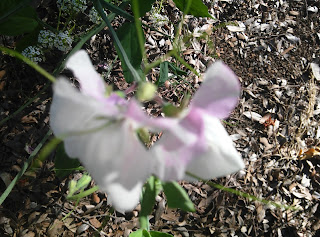Due to stranger-than-usual weather in the fall-winter of 2015-16, volunteer sweet peas sprouted in early October but did not bloom until March. Steve and I returned from a spring visit to Idaho on March 24 to find that spring had actually come on schedule to our SoCal location. (It usually comes in October or November, when I delight in calling it 'Fring.') California poppies, freesias, hyacinths, azaleas, and nasturtiums were in vibrant bloom, and buds were fattening on the Texas sundrops. But the sweet peas were what caught my eye.
Examining the sweet peas closely, I observed two specimens that were like nothing I'd ever seen before among my volunteers:
The upper image shows STREAKING of bright pink on white (or vice versa), and the lower one shows the WHITEST petals I've seen on volunteer sweet peas. Plain bright pink blossoms have appeared every year, and there have been plenty of light pink with white, but none where the white part of the petal has predominated. If I were a more dedicated follower of Gregor Mendel, I would save seed from these two to see what they would do next year, but it's more fun to wait and be surprised.
- - - - - -
* I do know enough about horticultural history to recall that streaking (most notably in tulips) can be the result of a virus. Going wild does have its risks.
** P.S. All-white blossoms have finally appeared on one of my volunteers. They're not in the parking strip, but in a bed devoted mostly to bulbs. This little vine is reaching out onto the sidewalk. Trying to get to the parking strip? When it dries out, I'll scatter its seed there. It could stay where it is, but I have ambitious plans to dig up and separate all my bulbs in August or September.



No comments:
Post a Comment